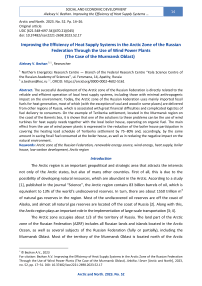Improving the Efficiency of Heat Supply Systems in the Arctic Zone of the Russian Federation Through the Use of Wind Power Plants (The Case of the Murmansk Oblast)
Автор: Bezhan A.V.
Журнал: Arctic and North @arctic-and-north
Рубрика: Social and economic development
Статья в выпуске: 52, 2023 года.
Бесплатный доступ
The successful development of the Arctic zone of the Russian Federation is directly related to the reliable and efficient operation of local heat supply systems, including those with minimal anthropogenic impact on the environment. Today, the Arctic zone of the Russian Federation uses mainly imported fossil fuels for heat generation, most of which (with the exception of coal and wood in some places) are delivered from other regions of Russia, which is associated with great financial difficulties and complicated logistics of fuel delivery to consumers. On the example of Teriberka settlement, located in the Murmansk region on the coast of the Barents Sea, it is shown that one of the solutions to these problems can be the use of wind turbines for heat supply needs together with the local boiler house, operating on organic fuel. The main effect from the use of wind power plants is expressed in the reduction of the boiler house participation in covering the heating load schedule of Teriberka settlement by 75-80% and, accordingly, by the same amount in saving fossil fuel consumed at the boiler house, as well as in reducing the negative impact on the natural environment.
Arctic zone of the Russian Federation, renewable energy source, wind energy, heat supply, boiler house, low-carbon development, Arctic region
Короткий адрес: https://sciup.org/148329471
IDR: 148329471 | УДК: [621.548+697.34](470.21)(045) | DOI: 10.37482/issn2221-2698.2023.52.17
Текст научной статьи Improving the Efficiency of Heat Supply Systems in the Arctic Zone of the Russian Federation Through the Use of Wind Power Plants (The Case of the Murmansk Oblast)
The Arctic region is an important geopolitical and strategic area that attracts the interests not only of the Arctic states, but also of many other countries. First of all, this is due to the possibility of developing natural resources, which are abundant in the Arctic. According to a study [1], published in the journal “Science”, the Arctic region contains 83 billion barrels of oil, which is equivalent to 13% of the world’s undiscovered reserves. In turn, there are about 1550 trillion m3 of natural gas reserves in the region. Most of the undiscovered oil reserves are off the coast of Alaska, and almost all natural gas reserves are located off the coast of Russia [2]. Along with this, the Arctic region plays an important role in the implementation of large-scale transportation [3; 4].
The Arctic zone occupies about 1/3 of the territory of Russia. The land part of the Arctic zone of the Russian Federation (AZRF) includes all Russian lands and islands located in the Arctic Ocean, as well as several subjects of the Russian Federation (fully or partially), including the Murmansk Oblast. Most of the territory of the Murmansk Oblast is located north of the Arctic
∗ © Bezhan A.V., 2023
Circle, so the climate here is severe subarctic, the main feature of which is long winters and short cold summers. The duration of the heating period in the region is about 8–9 months, and it can reach 12 months in some areas, which is the reason for the increased demand for thermal energy. In this regard, reliable and uninterrupted operation of heat supply systems is a mandatory requirement for the long-term existence and sustainable development of the region.
The Murmansk Oblast does not have its own sources of fossil fuels (coal, gas, oil), therefore, for the production of heat energy, fuel imported from other regions of Russia, significantly distant from the Murmansk Oblast, is mainly used. Let us refer to Fig. 1, which shows the structure of fuel and energy resources consumption for the purposes of heat generation by thermal power plants and boiler houses of the Murmansk Oblast. It can be seen that fuel oil and coal are predominantly used for heat energy generation, less frequently wood and electricity are used for direct water heating. The dependence of the Murmansk Oblast on fuel oil and coal supplies creates a risk for reliable and uninterrupted operation of heat supply systems.
Coal 18.54%
Electricity 3.20%
Diesel fuel 0.10%
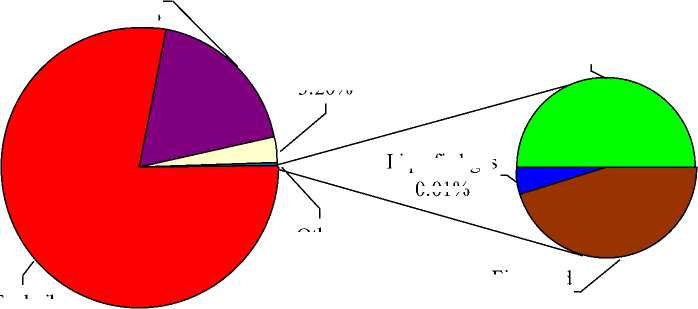
Liquefied gas
0.01%
Fuel oil
78.06%
Other 0.20%
Firewood 0.09%
Fig. 1. Stru gy p g ast.
The remoteness of the Murmansk Oblast from the places of fossil fuel production and the system of market pricing for fuel cause increased costs for fuel purchase and its delivery. This leads to the fact that the cost of heat energy is higher than the tariff at which organizations are obliged to supply it to consumers. As a result, the activities of most heat supply organizations in the Murmansk Oblast are unprofitable, and therefore, the state has to subsidize the purchase of fuel and its delivery to the territory of the Oblast in order to compensate for the lost income. One of the ways out in this situation can be the maximum use of local renewable energy sources (RES) together with traditional heat sources for heat supply needs. RES can reduce the participation of traditional heat sources in heat supply, and thereby save imported fossil fuel.
Of all the RES available in the Murmansk Oblast, wind energy has the greatest prospects for widespread development, where a separate direction of its use can be the use of wind power plants (WPP) together with boiler houses. The feasibility of using WPP for heat supply needs in specific areas and conditions should be confirmed by modern technical and economic calculations and analysis of the efficiency indicators. Many studies have been devoted to the study of these
SOCIAL AND ECONOMIC DEVELOPMENT
Aleksey V. Bezhan. Improving the Efficiency of Heat Supply Systems … issues, but all of them are mainly related to the analysis of hybrid energy systems, consisting, as a rule, of photovoltaic elements and WPP operating for power supply needs [5; 6]. At the same time, some studies still address the issues of heat supply from WPP, but heat and electric loads are considered together [7; 8]. Thus, the analysis of these and other similar studies has shown a lack of information on the efficiency of using WPP for heat supply, which could indicate that such use of wind turbines may be appropriate for some areas. In this regard, it seems important to assess the possible participation of WPP in the heat supply to consumers and the effect that can be obtained from the use of WPP together with boiler houses for heat supply needs.
Wind potential in the Murmansk Oblast and factors enabling its use for heat supply needs
A series of studies [9; 10] have been carried out earlier for preliminary assessment of the prospects of using WPP for heat supply needs in the Murmansk Oblast, the results of which indicate a high wind energy potential, characterized by an average annual wind speed at a height of 10 meters from the ground surface of 5-6 m/s on the White Sea coast and 7-9 m/s on the Barents Sea coast. At the same time, an important feature of the annual wind cycle was established — the highest wind speeds in the cold season (Fig. 2), when there is a winter maximum consumption of thermal energy. Thus, the high wind potential, combined with a long heating period, which is 8–9 months a year or more in the Murmansk Oblast, is a favorable prerequisite for the efficient use of wind energy for heat supply needs.
It should be noted that the power generated by WPP is highly dependent on wind speed, which has such a disadvantage as variability over time. Therefore, in order to provide consumers with electricity of the required quality, wind turbines are supplemented with special converting devices, as well as with complex mechanical and electronic control systems that ensure the generation of electricity from high-quality wind turbines in a continuous mode [11; 12]. In the case of using wind energy for heat supply needs, high requirements to the quality of energy produced by WPP are not necessary. This circumstance can be explained by the fact that short-term second and minute fluctuations of the power produced by wind turbines are smoothed out by the coolant itself, as well as by the inertia of heat supply systems. Longer fluctuations (over several hours) are leveled off due to the heat storage capacity of heated buildings. During a long absence of wind, heat accumulators or duplicating traditional fossil fuel heat sources can be used. Thus, low requirements to the quality parameters of the energy generated by wind turbines make it possible to use WPP built in a simple design, making them cheaper and more reliable in operation.
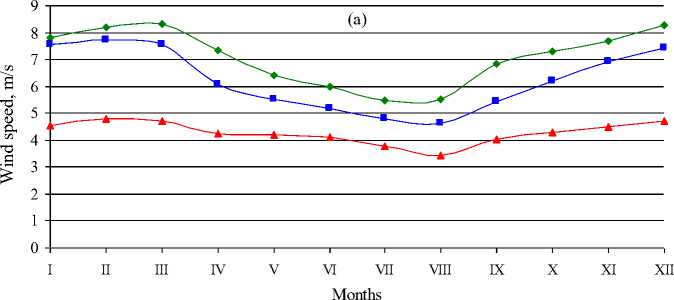
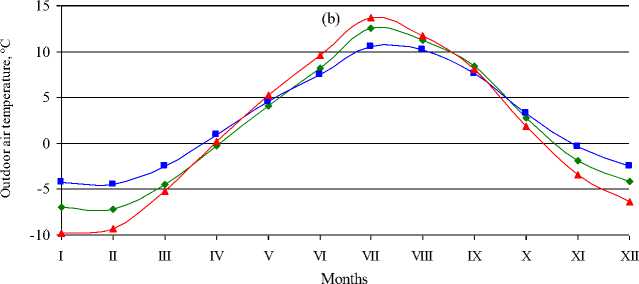
Fig. 2. The annual course of long-term average monthly wind speeds (a) and the change in long-term average monthly values of outdoor air temperature (b) in the twenty-year period 2001-2020: green, blue, and red curves are weather stations Teriberka, Vayda-Guba, and Murmansk, respectively.
Research methods and materials
Modern centralized heat supply systems are a complex set of various elements, the main of them are sources (thermal power plants or boiler houses) and consumers (complex of heated buildings) of heat energy, interconnected by heat networks. The scheme of a heat supply system, which includes a boiler room, looks as shown in fig. 3a. The main purpose of such a heat supply system is the transfer of thermal energy from the boiler house to heated buildings in order to cover their thermal (heating) load. In this case, the heating load of a particular district or an entire settlement, covered by a boiler house during the day, can be determined by the following formula:
Q 0 = Q kot = ( q : T ■ k . ■ ( T b - T h )Ж р ■ ( Т в - т, р ) ) . (1)
where QKom — power output of the boiler house during the day, Gcal/h (MW); QmT — estimated connected load of the boiler house, Gcal/h (MW); Тв = 18°С (internal air temperature for residential, administrative and public buildings 1 [13]); V and Тн — average daily values of wind speed and outdoor air temperature, for which it is required to determine the heating load, m/s and °C; kv — coefficient of heat loss increase from wind speed, units. (Fig. 4); TH.р — estimated outdoor air temperature of the coldest five-day period of eight winters during the fifty- year period 2; vр — estimated wind speed, defined as the maximum of the average wind speeds by rhumb lines for January 3; k — coefficient vр
of heat loss increase from the calculated wind
speed (Fig. 4).

(а)
(б)
Fig. 3. Scheme of the heat supply system based on the boiler house (a) and the “boiler house + WPP” complex (b).
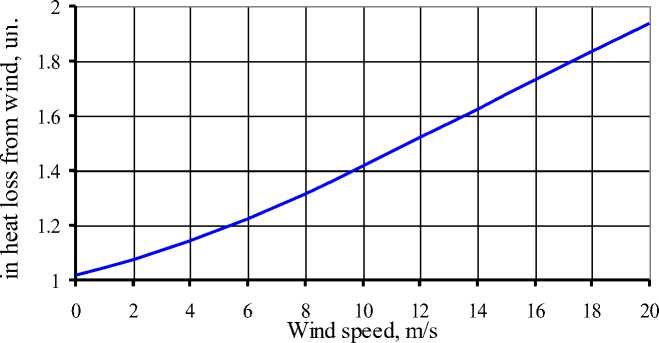
Fig. 4. Relative increase in building heat loss from wind speed [4].
The variation of the heating load during the whole heating period can be represented in the form of a graph of the annual duration of heating loads. Knowing how the average daily outdoor temperature and wind speed change during the entire heating period, using formula (1), it is possible to calculate and build the annual heating load schedule covered by the boiler house. In this case, the data of the archive of long-term meteorological observations of the outdoor air temperature and wind speed, which are contained in the specialized databases “RIHMI-WDC”, “Weather of Russia”, “Weather Schedule” and others, can be used as initial information.
Let us introduce the parameter ф , which will indicate the share of participation of boiler house in covering the heating load schedule. If heat supply is carried out from one boiler house (Fig. 3a), then ф =1.
To increase the efficiency of the heat supply system, it is possible to use a combined heat and power plant as an additional source of heat energy together with a boiler house. In this case, the scheme of the heat supply system, originally presented in Fig. 3a, will now look like the one shown in Fig. 3b. In this option of heat supply, part of the heating load schedule will be covered by the WPP as a priority, and the rest — by the boiler house. Then the formula that determines the value of the heating load can be written as following:
Q 0 = Q kot + Q - - QZ = (QZ ■ k v ■ ( T b — T. ) ) / (k. р ■ (Т в — t„ ) ) , (2)
where Q ВЭУ — power produced by the wind turbine, Gcal/h (MW); Q В из Э б У — wind turbine excess capacity, Gcal/h (MW).
To calculate the power output of a wind turbine, it is necessary to know the average wind speed for a 10-minute time interval at the height of the tower in the selected area of the wind turbine location and the operating characteristic of the WPP. The values of the average wind speed for a 10-minute time interval are obtained using measurements of meteorological instruments installed at a certain height (in our case, at the height of the wind turbine tower) on the meteorological mast.
Formula (2) characterizes the process in which the share of boiler house participation in covering the heating load schedule ф is less than 1. At the same time, the smaller ф is, the greater the effect of the use of wind turbines for heat supply needs is achieved. If we denote that Q ВЭУ / Q 0 is the share of participation of the wind turbine in covering the heating load for a 10-minute time interval, then ф = 1 - QB3y / Q 0 is the share of participation of the boiler house in covering the heating load in the joint operation of the boiler house and the wind turbine also for a 10-minute time interval.
To calculate ф for a longer time period, for a month or a year, the following formula can be used:
Ф т = 1 -
''
X Q B-Vf i = 1
I j = 1 ;
( A
/ X Q о j
I j = 1 ;
where j =1, 2, ., m — the number of the day, units; m — the number of days for which it is necessary to determine ф , units; i =1, 2, ., n — the number of the 10-minute time interval, units; n — the number of 10-minute time intervals in m , units. For example, at m =31, i.e. for a month with 31 days, n =4464, and for a year with 365 days, n =52560.
In more detail, the operation of a wind turbine together with a boiler house can be explained as follows:
-
1. If QВЭУ - Q 0 , then the wind turbine is able to fully cover the heating load schedule and the participation of the boiler house is not required ( QKom = 0 , ^ =0). At the same time, during periods with strong wind ( QВЭУ > Q 0 ), the wind turbine can create excess power О ВизбУ , which can be stored in a heat accumulator in the form of hot water or dissipated into the environment. But this is the subject of a separate study and will not be considered in this article.
-
2. If QВЭУ < Q 0 , then the power of the wind turbine is not enough to cover the heating load schedule and the boiler house supplements the work of the wind turbine ( 0 < ^ < 1 , where Ф = 1 - Q B 3y / Q o )•
-
3. If Qw y = 0 , then this corresponds to periods of cold low-wind weather, when the entire heating load falls on the boiler house (
=1).
Research results
One of the consumers experiencing difficulties with heat supply is the village of Teriberka (Teriberka settlement). It is a settlement in the Murmansk Oblast on the coast of the Barents Sea. The village is centrally supplied with heat from an oil-fueled boiler house with a maximum connected load of 1.8 Gcal/h (2.1 MW). The heat supply scheme is two-pipe with heat supply for heating. Hot water supply is provided by water heaters in apartments.
On the example of this settlement, a series of calculations was carried out to assess the possible using of wind turbines together with the local boiler house in the heat supply of the village and the effect that can be obtained from the use of WPP. During the calculations, it was assumed that heat losses in pipelines of the heating network and heating systems of buildings, as well as energy losses during its transmission from wind turbines, will not be taken into account. The calculations were carried out in two stages.
At the first stage, according to the data of meteorological observations of the outdoor air temperature and wind speed, carried out in Teriberka in the period from 2019 to 2021 (Fig. 5), using the formula (1), the values of the heating load covered by the boiler house were calculated. The parameters included in formula (1) were taken as follows: Qmax = 2.1 MW; Тв = 18°С; Тн. р = -21°С; kv = 1.46, which corresponds to vn = 10.9 m/s (Fig. 4). The results of such calculations are vр р shown in Fig. 6 in the form of annual heating load curves. The figure shows that the heat demand varies significantly during the heating period. This is mainly due to changes in heat loss to the environment, resulting from fluctuations in outdoor temperature and wind speed.

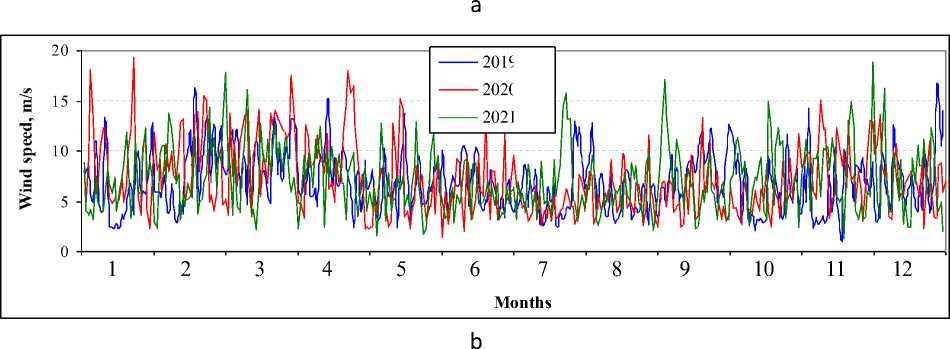
Fig. 5. Graphs of changes in the average daily values of outdoor air temperature (a) and wind speed (b) in Teriberka for the period from 2019 to 2021.
To improve the efficiency of the heat supply system in Teriberka, it is proposed to use two Vestas V52/850 wind turbines with a total capacity of 1.7 MW (81% of the connected load of the boiler house) and a tower height of 65 m together with the boiler house. To calculate the power output of the wind turbines, the average 10-minute wind speed values for a three-year period (from 2019 to 2021), measured at a height of 65 metres near Teriberka, were used. The operating characteristic of the wind turbine is shown in fig. 7. Based on these data, annual graphs of the change in the power output of wind turbines were built, and together with them, using formula (2), the possible participation of wind turbines in covering the heating load schedules of Teriberka, originally shown in fig. 6. These constructions are presented in fig. 8. It shows that when the boiler house and the wind turbine work together, the main part of the heating load is covered by the wind turbine (Fig. 8, blue area), and the rest — by the boiler house (Fig. 8, red area), supplementing the work of the wind turbine during periods with little or no wind. When the value of wind turbine power exceeds the hourly demand of all heated buildings in thermal energy, excess WPP power is generated (Fig. 8, grey area).
о
о
о
2.2
1.8
1.6 1.4 1.2
1 0.8 0.6 0.4 0.2
о
о
й
о
2.2
1.8
1.6 1.4 1.2
1 0.8 0.6 0.4 0.2
о
о
й
о
2.2
1.8
1.6 1.4 1.2
1 0.8 0.6 0.4 0.2

Q br
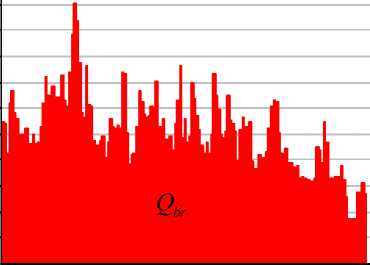

Q
6 7
Months
6 7
Months
6 7
Months
_______■
8 9

Q br
11 12

ku
ян
Q br
Fig. 6. Annual schedules of the heating load in Teriberka, covered by the boiler house.
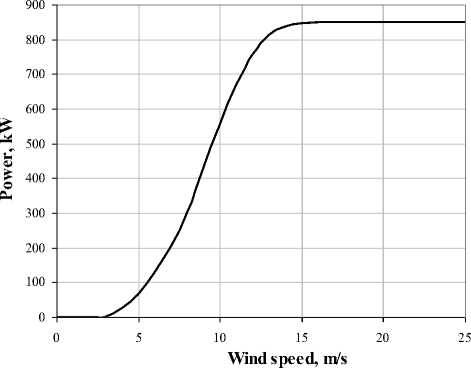
Fig. 7. Operating characteristic of Vestas V52/850 wind turbine.
At the second stage, according to the data, the effect that can be obtained from the use of wind turbines for the needs of heat supply in Teriberka was determined. As mentioned earlier, the main effect of the use of WPP can be shown as a decrease in the share of the boiler house in covering the heating load schedule. For this purpose, the values of the boiler house share in the heating load coverage were calculated using formula (3) for the joint operation of the boiler house and wind turbines for each month and for the whole year. The results of such calculations are presented in the form of a diagram in fig. 9, which shows that wind turbines are able to reduce the participation of the boiler house in covering the heating load schedule of the village of Teriberka by 60–90% in certain months, and by about 75–80% in general for the year, as well as to ensure fuel (fuel oil) economy by the same amount consumed in the boiler house. In physical terms, this is equivalent to a decrease in thermal energy generation of the boiler house by 3.88 thousand Gcal (4507.5 MWh) in 2019, by 4.0 thousand Gcal (4647.9 MWh) in 2020 and by 4.01 thousand Gcal (4667.7 MWh) in 2021. Taking into account that the weighted average standard of specific fuel consumption for the production of thermal energy and the weighted average efficiency of the boiler units of the fuel oil boiler house in Teriberka are 210.19 kg of reference fuel/Gcal and 67.97%, respectively, then with such indicators of the boiler house, the volume of saved fuel (fuel oil) will amount to 0.57 thousand tons of fuel per year on average.
When burning fuel oil in the amount of 1 ton, 2.27 tons of carbon dioxide are emitted 4. Consequently, with an annual saving of fuel oil in the amount of 0.57 thousand tons of fuel equivalent, carbon dioxide emissions will decrease by 1.29 thousand tons per year, which will contribute to improving the environmental situation in Teriberka and preserving the health of the local population. Reduction in carbon dioxide emissions will generate additional revenue in the future. This will be possible due to the implementation of the Strategy for the socio-economic development of the Russian Federation with low greenhouse gas emissions up to 2050, which will allow the sale of greenhouse gas emission quotas to companies that have not implemented emission reduction projects at their facilities. This circumstance increases the effect of using wind power plants for heat supply.
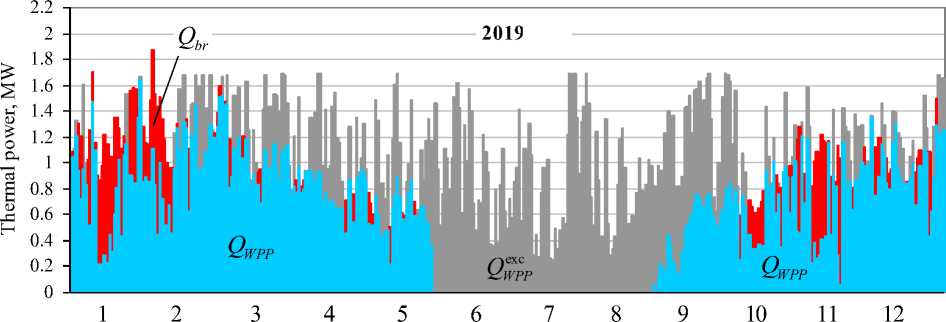
Months
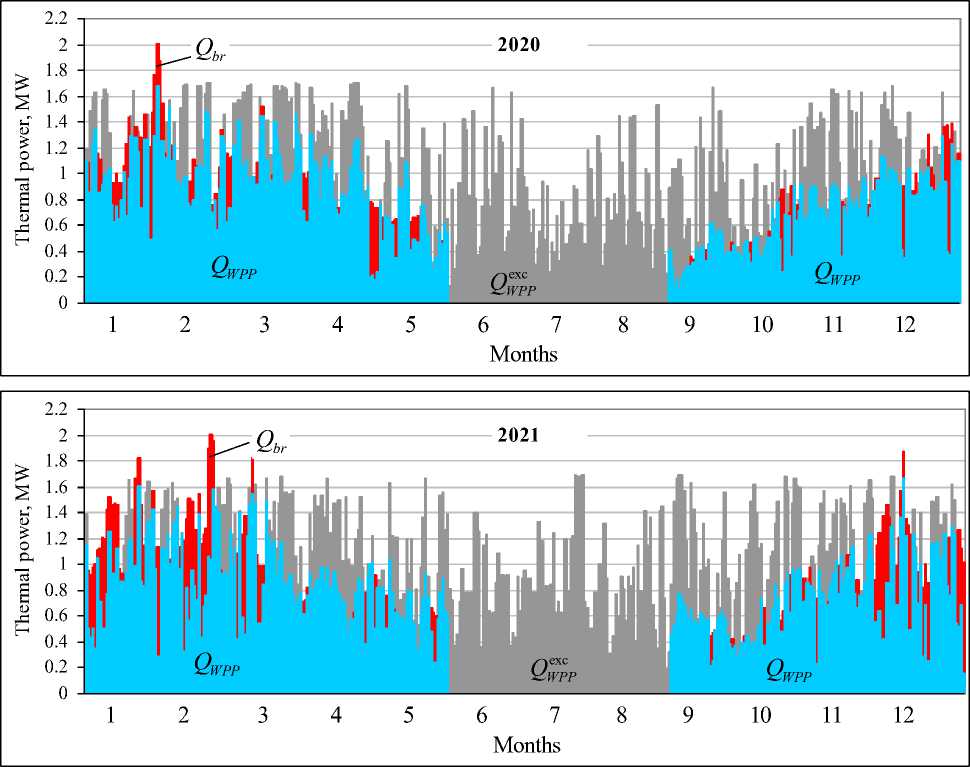
Fig. 8. Combined operation of the boiler house and wind turbines to cover the heating load schedules of Teriberka: areas of blue and red colors are the power output of the wind turbine and boiler house, respectively; the grey area is the excess capacity of the wind turbine.
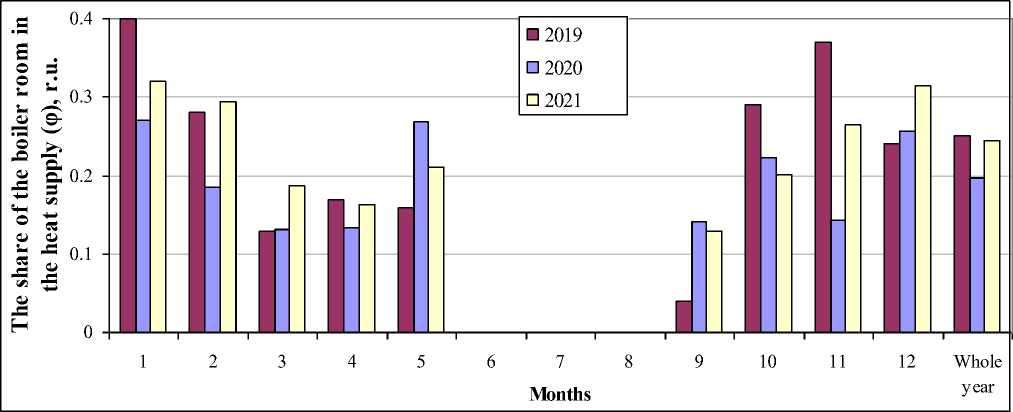
Fig. 9. Share of boiler house participation in covering the heating load in Teriberka in combined operation of the boiler house and wind turbines for heat supply needs.
Conclusion
In areas of the Arctic zone of the Russian Federation with a high wind potential to improve the efficiency of local heat supply systems, it is possible to use wind power plants together with traditional heat sources operating on fossil fuels for heat supply needs. In this case, the main effect of using wind turbines is to reduce the participation of traditional heat sources in the heat supply of consumers and, as a consequence, to save fossil fuels, as well as to reduce the negative impact on the environment.
On the example of Teriberka settlement, located in Murmansk Oblast in the area with average annual wind speed at the height of 10 meters from the ground surface of 7 m/s and heating season of 9 months, the work of two wind turbines with total capacity of 1.7 MW together with the local boiler house to cover the heating load schedule of this settlement is shown. The efficiency of wind turbines was assessed, which showed that use of WPPs can reduce the participation of the boiler house in covering the heating load of the village of Teriberka and thereby ensure savings in fossil fuel consumed by the boiler house by 75–80%, as well as reduce the harmful emissions of the boiler house by the same amount. In future, this will generate additional income from the sale of greenhouse gas emission quotas to companies that have not implemented emission reduction projects at their facilities.
In general, the use of wind energy in heat generation technologies for heat supply to consumers located in the regions of the Arctic zone of the Russian Federation is of great socioeconomic importance for the further development and successful exploration of these areas. First of all, it is associated with the possibility of increasing the efficiency and reliability of local heat supply systems, which becomes possible due to the substitution of heat energy obtained from the combustion of fossil fuels with the energy produced by wind turbines, and, as a consequence, due to the reduced dependence on fossil fuel supplies. In turn, this will minimize the problems of fossil fuel delivery to the Russian Arctic regions and reduce state subsidies for its purchase, which is especially important due to the current difficult economic conditions in the country.
Список литературы Improving the Efficiency of Heat Supply Systems in the Arctic Zone of the Russian Federation Through the Use of Wind Power Plants (The Case of the Murmansk Oblast)
- Gautier D.L., Bird K.J., Charpentier R.R., Grantz A., Houseknecht D.W., Klett T.R. et al. Assessment of Undiscovered Oil and Gas in the Arctic. Science, 2009, vol. 324 (5931), pp. 1175–1179. DOI: 10.1126/science.1169467
- Melamed I.I., Avdeev M.A., Pavlenko V.I., Kutsenko S.Ju. Arkticheskaya zona Rossii v sotsial'no-ekonomicheskom razvitii strany [The Arctic Zone of Russia in the Context of the Socio-Economic Development of the Country]. Vlast' [The Authority], 2015, vol. 23, no. 1, pp. 5–11.
- Osipova E.E., Smirnov S.V., Khairova T.A. Preconditions for the Development of Russian Arctic Export, Coastal (Cabotage) Transportation and Project Cargo for the Arctic Demand. Arktika i Sever [Arctic and North], 2019, no. 37, pp. 5–21. DOI: 10.17238/issn2221-2698.2019.37.5
- Serova N.A., Serova V.A. Critical Tendencies of the Transport Infrastructure Development in the Russian Arctic. Arktika i Sever [Arctic and North], 2019, no. 36, pp. 42–56. DOI: 10.17238/issn2221-2698.2019.36.42
- Celik A. Optimisation and Techno-Economic Analysis of Autonomous Photovoltaic–Wind Hybrid Energy Systems in Comparison to Single Photovoltaic and Wind Systems. Energy Conversion and Management, 2002, vol. 43, iss. 18, pp. 2453–2468. DOI: 10.1016/s0196-8904(01)00198-4
- Mamaghani A.H., Avella S., Najafi B., Shirazi A., Rinaldi F. Techno-Economic Feasibility of Photovoltaic, Wind, Diesel and Hybrid Electrification Systems for Off-Grid Rural Electrification in Colombia. Renewable Energy, 2016, vol. 97, pp. 293–305. DOI: 10.1016/j.renene.2016.05.086
- Sagani A., Vrettakos G., Dedoussis V. Viability Assessment of a Combined Hybrid Electricity and Heat System for Remote Household Applications. Solar Energy, 2017, vol. 151, pp. 33–47. DOI: 10.1016/j.solener.2017.05.011
- Ozgener O. Use of Solar Assisted Geothermal Heat Pump and Small Wind Turbine Systems for Heating Agricultural and Residential Buildings. Energy, 2010, vol. 35, iss. 1, pp. 262–268. DOI: 10.1016/j.energy.2009.09.018
- Minin V.A., Dmitriev G.S., Ivanova E.A., Moroshkina T.N., Nikiforova G.V., Bezhan A.V. Energiya vetra — perspektivnyy vozobnovlyaemyy energoresurs Murmanskoy oblasti [Wind Energy as a Promising Renewable Energy Resource of the Murmansk Region]. Apatity, KSC RAS Publ., 2006, 73 p. (In Russ.)
- Minin V.A., Bezhan A.V. Perspektivy ispol'zovaniya energii vetra dlya teplosnabzheniya potrebiteley evropeyskogo Severa [Prospects for the Use of Wind Energy for Heat Supply to Consumers in the European North]. Apatity, KSC RAN Publ., 2009, 56 p. (In Russ.)
- Gupta A., Dr. Shandilya A. Challenges of Integration of Wind Power on Power System Grid: A Review. International Journal of Emerging Technology and Advanced Engineering, 2014, vol. 4, iss. 4, pp. 880–884.
- De Alegria I.M., Andreu J., Martin J.L., Ibañez P., Villate J.L., Camblong H. Connection Requirements for Wind Farms: A Survey on Technical Requirements and Regulation. Renewable and Sustainable Energy Reviews, 2007, vol. 11 (8), pp. 1858–1872. DOI: 10.1016/j.rser.2006.01.008
- Metodika opredeleniya potrebnosti v toplive, elektricheskoy energii i vode pri proizvodstve i peredache teplovoy energii i teplonositeley v sistemakh kommunal'nogo teplosnabzheniya [Methodology for Determining the Need for Fuel, Electric Energy and Water in the Production and Transmission of Thermal Energy and Heat Carriers in Municipal Heat Supply Systems]. Moscow, FSUE “Center For Design Products” Publ., 2004, 76 p. (In Russ.)

